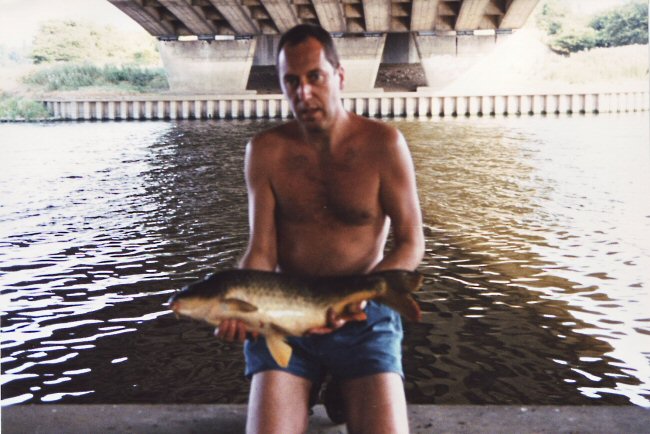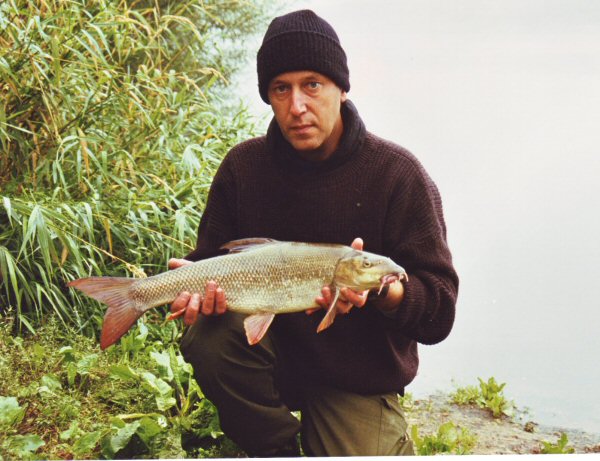The
idiot's guide to carp fishing in rivers - part 4
The Bridge
It's all very well aspiring to idyllic surroundings, with damsel flies dipping onto sun-dappled waters and the sounds of running waters, lulling you into a hypnotic trance; sometimes, if you really need a fish, you simply have to get down and dirty, which is how I found myself sitting beneath a concrete bridge, beneath one of the country's main arterial roads.
Under the A1 road bridge:
a bit like being in the vaults of a cathedral designed by the Reverend Ian
Paisley.
It can be surprisingly cold under here, even when the sun is baking the banks
on either side
Ready to rumble
South Muskham Fisheries is actually equidistant between the villages of North
and South Muskham and comprises five gravel pits and a one and a half mile
length of river fishing on the Trent. The first twenty pegs are on a pacy
stretch of river that leads to its confluence with the Newark Dyke at Crankley
Point. To say these are heavily fished would be an under statement; at times
you even see people queuing up to fish and in the summer months, some of the
pegs are fished around the clock for weeks on end. The reason is that it is
absolutely stuffed with fish, but far more fish are lost than landed. Pegs
5 and 6 are opposite a sunken barge, but because of the strength of the current,
the line to lead weight ratios start to get tricky. I used to struggle to
hold out with a 4oz lead and 10lb line, but I saw people seemingly managing
it with lighter gear with heavy feeders - presumably with a shock leader.
I was once fishing one of the middle pegs (7 or 8 I think), when because the
rod rests had to be positioned in the water, a vicious take spun me on my
feet and nearly pulled the rod out of my hand. The point itself looks great,
but because of the current and the floating weed, is almost unfishable.
Peg 1 on the Crankley Point stretch. Nottingham Piscatorials own the easy pegs on the far bank
A quarter of a mile past Crankley Point , the Trent is crossed by the A1 road bridge. This is not one of the most picturesque backdrops for a carping session, but it has the distinct advantage of being one of the few swims where you can almost guarantee a run during even the hottest weather. In fact, I suspect that it is on days when the sun is at its brightest and most intense, that you have the best chance of a fish or two. Although the main road traffic rushes past overhead, it is actually quieter right next to or under the bridge, than when you are a couple of hundred yards away.
Contemplation: the best time to fish this swim is on a baking hot summer's day, between 10am and mid-day
The bridge arch is brutally impressive as it spans out across the river, its unyieding presence lightened only by the reflected sunlight that dances hypnotically upon the cold concrete beams and pillars. In the muted light it could almost be the vaults of a cathedral, albeit one designed by The Reverend Ian Paisley in a particularly grumpy mood.
Your first mental task is to accustom yourself to the continual clunk and thump of the bridge joints as the lorries thunder past overhead. Then there is the wind, which is funnelled along the river and through the bridge arch, stirring up the fine dust that gets into your car, your clothes and your food. The breeze is actually a bonus during the baking heat of the summer, but miserable as sin on dull, rainy days. To take full advantage of this sunny day swim, you have to set up right under the bridge itself, and position yourself about mid-way along the high concrete ledge A rod pod is useful here, but I prefer to put a long, extending bankstick into the river bed just out from the ledge itself. If the atmosphere gets too depressing, you can warm up in the sun for a few minutes without being too far from your rods, but be on your guard, because they will be out of site behind the pillars. If the wind is particularly bitter, you can drive your car almost up to your rods and watch from inside, but make sure the handbrake is working properly.
At summer level, the gravel beyond the concrete ledge should be exposed enough for you to leap down to water level. Then, by keeping the trajectory low, you should be able to catapult a few loose boilies upstream, aiming for at least two thirds to three quarters of the way across. Casting is also made easier from this lower position, with less chance of smashing your rod tip on the concrete beams. If you can master a sideways pendulum cast then so much the better, but even so, you will still flatten a few leads on the bridge arch and decapitate a few pigeons.
You will need a minimum of three and a half ounces of lead to hold out two thirds of the way across and even then, it will help if you can keep the rod tips as high as possible. I have given up using stringers, as at least fifty percent of the time, they cause your lead to move considerably before settling, thereby cancelling out their modus operandi. The current is deceptively swift, so cast slightly upstream and release a few yards of line as the lead hits the water - beach fishing style. I did once take a fish about a third of the way across, but I feel far happier with the baits out twice that distance. How deep is it out there? I have no idea, as plumbing in a strong current is impossible from the bank. I would guess it at about twelve feet, but the important thing is that it is deep enough for boats to pass over without snagging the line. If anyone would like to stand on the top of the A1 bridge and do the job accurately, then I would be more than happy to add a footnote.
Nearly all the runs from this swim come between 10am and mid-day, which I feel is quite decently civilised. On one of my early attempts from this spot, I sat just outside the bridge arch, reading the Sunday papers in the morning sunshine. As I sat there, gradually acquiring a coating of dead flies from the road above, I suddenly heard a strange noise. It was a bit like one of the whining vehicles passing by, yet somehow angrier. Half stupefied by the hot sun it took me a second or two to realise what it was, then suddenly the penny dropped. The rod was out of the back rest and was pointing downstream with the clutch still spinning, while the alarm was screaming like a banshee.
The fish had covered an impressive distance in a very short time and was now heading for the nearside, downstream reed bed, which stopped me from following it on foot. I leaped down onto the gravel and held the rod out at armís length until it stopped, kicked, then slapped the surface, somewhere downstream and out of sight. The only tactic in this kind of situation is to slacken off and maintain minimal contact, then hope for the best. By keeping very gentle pressure on I almost walked it upstream, until it approached the end of the reeds and shot off towards the middle again. This was certainly exciting stuff, and it made several more strong runs before I was able to net it. It was what I would later find out to be a fairly typical, low-double common, but by god, they do you good.

Glamorous, soft-focus shot showing the typical size of carp to be expected. Big ones do turn up though and there were rumours of a near thirty. The beauty of it is that you can never really be sure what will turn up next
I later came to regard this as the hangover swim; I never had a run before 10am, so getting up at the crack of dawn was never unnecessary. My best tally in this two-hour period was three commons between ten and twelve pounds, plus the inevitable two or three chub. After mid-day, it is probably best to move up to one of the Crankley Point swims, or else down to the early 100ís, which give you a better chance in the evening.
You like rats donít you? Just upstream of the bridge is (was?) a fairly open swim on a gravel slope that can be well worth fishing at night. The only snag is that you will have to sit at the top of the bank and run like hell down to the bottom if you get a run. This is great fun in the dark, as the bank slopes at various angles on the way down, with strategically placed bumps and holes to trip you up. There is a lay-by on the road above, which is a well-known meeting place for criminals, but at least itís somewhere for the emergency services to park when they come to drag your broken body up the steep embankment into the ambulance. Don't even think about fishing under the bridge after dark; it's blacker than a cloudy night on a new moon under there. But that is the least of your worries: the hollow cavities under the bridge foundations are rat city; you are an invader, you are outnumbered and you are on the menu.

The Newark Dyke (uppermost) is the wider of the two rivers at this point. The point looks a great holding spot, but is silty and snaggy, with the constant nuisance of floating weed snagging your lines in the fast current

A barbel from just downsteam of the barge pegs, caught close in on sweetcorn, using a 1 ounce lead